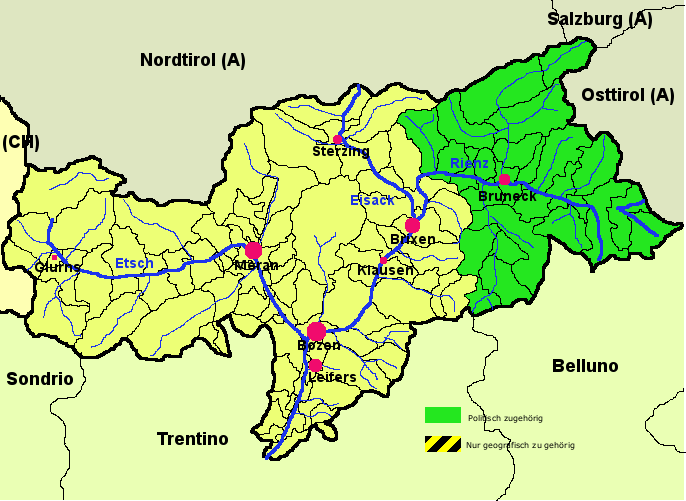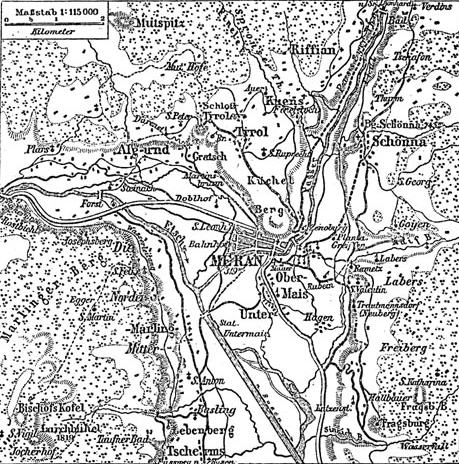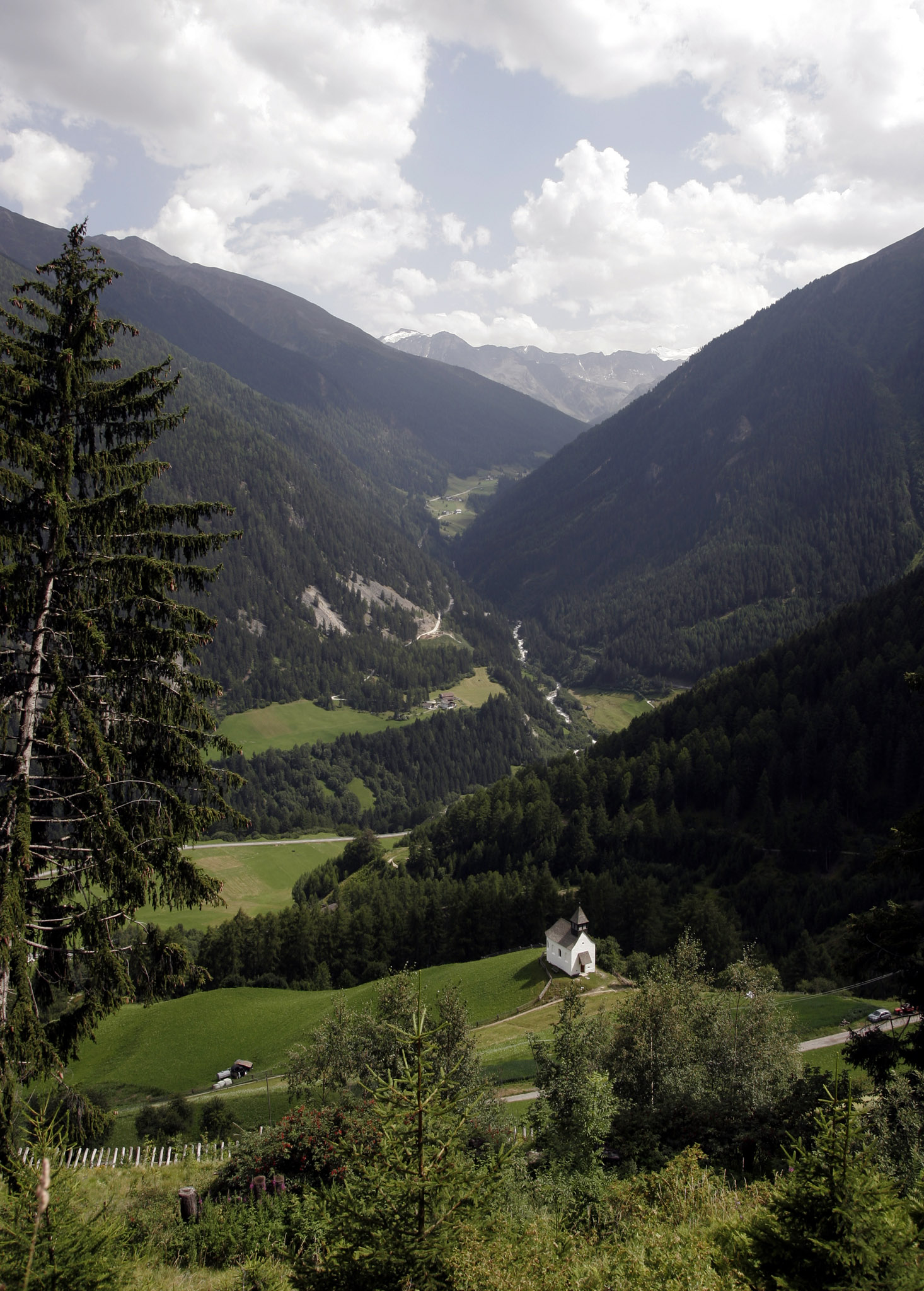|
Val Venosta
The Vinschgau, Vintschgau () or Vinschgau Valley ( ; ; ; medieval toponym: ''Finsgowe'') is the upper part of the Adige or Etsch river valley, in the western part of the province of South Tyrol, Italy. Etymology The German name ''Vinschgau'', like Italian ''Val Venosta'', is derived from the Celtic (Rhaetian) Venostes tribes mentioned on the ancient Tropaeum Alpium. A Frankish '' Gau'' was established under Charlemagne in 772; it was first mentioned in a 1077 deed, when King Henry IV of Germany granted the estates of Schlanders ''in pago Finsgowe'' to Bishop Altwin of Brixen. Geography The Vinschgau ValleyAllgemeiner historischer Handatlas, Gustav Droysen runs in a west-east orientation, from the Merano basin at Partschins up the Adige river to Reschen Pass in the northwest. The Ötztal Alps in the north, part of the Alpine crest, separate it from the upper Inn Valley. The Adige valley is further confined by the Sesvenna Alps in the west and the Ortler Alps in the south. ... [...More Info...] [...Related Items...] OR: [Wikipedia] [Google] [Baidu] |
Districts Of Trentino-Alto Adige/Südtirol
The Districts of Trentino-Alto Adige/Südtirol are a subdivision of the two Italy, Italian autonomous Provinces of Italy, provinces of Trento (''Trentino'') and Bolzano (''South Tyrol''). They were established by a decree of the President of Italy (Nr. 987) on 10 June 1955. In South Tyrol their name is ''Comunità comprensoriale'' or ''Comprensorio'' (in Italian language, Italian), ''Bezirksgemeinschaft'' (in German language, German), ''Cumunità raion'' or ''Comunitè comprensoriala'' (in Ladin language, Ladin). In Trentino is ''Comunità di valle'' (in Italian language, Italian) and ''Talgemeinschaft'' (in German language, German). South Tyrol South Tyrol is composed by 8 ''Comprensori''/''Bezirksgemeinschaften''. One of them, Bolzano, is urban and composed only by the city. The city is also the seat of Salten-Schlern, but not part of its territory. Trentino Until 16 June 2006, Trentino was divided into 11 ''Comprensori''/''Bezirksgemeinschaften'', abolished with a provincial ... [...More Info...] [...Related Items...] OR: [Wikipedia] [Google] [Baidu] |
Merano
Merano (, ; ) or Meran () is a (municipality) in South Tyrol, Northern Italy. Generally best known for its Spa town, spa resorts, it is located within a Depression (geology), basin, surrounded by mountains standing up to Height above mean sea level, above sea level, at the entrance to the Passeier Valley and the Vinschgau. The city has been a popular place of residence for several scientists, literary people, and artists, including Franz Kafka, Paul Lazarsfeld and also Empress Elisabeth of Austria, who appreciated its mild climate. Name Both the Italian () and the German () names for the city are used in English. The Ladin language, Ladin form of the name is . The official name of the municipality (''comune'') is ''Comune di Merano'' in Italian and ''Stadtgemeinde Meran'' in German (both are in official use). History Archaic names of the city are ''Mairania'' (from AD 857) and ''an der Meran'' (from the 15th century). In 17th-century Latin language, Latin, the city was called ... [...More Info...] [...Related Items...] OR: [Wikipedia] [Google] [Baidu] |
Viticulture
Viticulture (, "vine-growing"), viniculture (, "wine-growing"), or winegrowing is the cultivation and harvesting of grapes. It is a branch of the science of horticulture. While the native territory of ''Vitis vinifera'', the common grape vine, ranges from Western Europe to the Persian shores of the Caspian Sea, the vine has demonstrated high levels of adaptability to new environments, hence viticulture can be found on every continent except Antarctica. The duties of a viticulturist include monitoring and controlling pests and diseases, fertilizing, irrigation, canopy management, monitoring fruit development and characteristics, deciding when to harvest, and vine pruning during the winter months. Viticulturists are often intimately involved with winemakers, because vineyard management and the resulting grape characteristics provide the basis from which winemaking can begin. A great number of varieties are now approved in the European Union as true grapes for winegrowin ... [...More Info...] [...Related Items...] OR: [Wikipedia] [Google] [Baidu] |
Apple
An apple is a round, edible fruit produced by an apple tree (''Malus'' spp.). Fruit trees of the orchard or domestic apple (''Malus domestica''), the most widely grown in the genus, are agriculture, cultivated worldwide. The tree originated in Central Asia, where its wild ancestor, ''Malus sieversii'', is still found. Apples have been grown for thousands of years in Eurasia before they were introduced to North America by European colonization of the Americas, European colonists. Apples have cultural significance in many mythological, mythologies (including Norse mythology, Norse and Greek mythology, Greek) and religions (such as Christianity in Europe). Apples grown from seeds tend to be very different from those of their parents, and the resultant fruit frequently lacks desired characteristics. For commercial purposes, including botanical evaluation, apple cultivars are propagated by clonal grafting onto rootstocks. Apple trees grown without rootstocks tend to be larger and ... [...More Info...] [...Related Items...] OR: [Wikipedia] [Google] [Baidu] |
Central Eastern Alps
The Central Eastern Alps (), also referred to as Austrian Central Alps () or just Central Alps, comprise the main chain of the Eastern Alps in Austria and the adjacent regions of Switzerland, Liechtenstein, Italy and Slovenia. South of them is the Southern Limestone Alps. The term "Central Alps" is very common in the Geography of Austria as one of the seven major landscape regions of the country. "Central Eastern Alps" is usually used in connection with the Alpine Club classification of the Eastern Alps (''Alpenvereinseinteilung'', AVE). The Central Alps form the eastern part of the Alpine divide, its central chain of mountains, as well as those ranges that extend or accompany it to the north and south. The highest mountain in the Austrian Central Alps is Grossglockner at . Location The Central Alps have the highest peaks of the Eastern Alps, and are located between the Northern Limestone Alps and the Southern Limestone Alps, from which they differ in geological composi ... [...More Info...] [...Related Items...] OR: [Wikipedia] [Google] [Baidu] |
Schnalstal
The Schnalstal () is a side valley of the Vinschgau in the autonomous administrative division, autonomous province of South Tyrol, Italy. It belongs almost in its entirety to the municipality of Schnals, while small parts in the entrance area lie in Naturns und Kastelbell-Tschars. The Vernagt-Stausee reservoir is located in the valley. Braunes Bergschaf, a rare breed of domesticated sheep, is raised there. In 1991, Ötzi -- a well-preserved natural mummy from about 3300 BC -- was found in the nearby Schnalstal glacier. References External links Tourism agency of Schnalstal * Valleys of South Tyrol {{Expand German, topic=geo, date=December 2013 ... [...More Info...] [...Related Items...] OR: [Wikipedia] [Google] [Baidu] |
Matscher Tal
The Matscher Tal (also ; ) is a side valley of the Vinschgau in South Tyrol, Italy. It is part of the municipality of Mals Mals (; ) is a ''comune'' (municipality) and a village in South Tyrol in northern Italy, located about northwest of Bolzano, on the border with Switzerland and Austria. History Coat-of-arms The emblem is party per fess: the upper of gules a .... References Alpenverein South Tyrol External links Valleys of South Tyrol {{TrentinoAltoAdige-geo-stub ... [...More Info...] [...Related Items...] OR: [Wikipedia] [Google] [Baidu] |
Suldental
The Suldental (; ) is a side valley of the Trafoi Valley in South Tyrol, Italy. The village in the valley is Sulden Sulden (; ) is a mountain village in South Tyrol, northern Italy. It is a ''frazione'' of the ''comune'' of Stilfs. Geography Sulden lies at the foot of the Ortler, in the Vinschgau valley east of the Stelvio Pass. It is 1900 m above sea level .... ReferencesAlpenverein South Tyrol External links Valleys of South Tyrol {{Tyrol-geo-stub ... [...More Info...] [...Related Items...] OR: [Wikipedia] [Google] [Baidu] |
Ortler Alps
The Ortler Alps ( ; ; ) are a mountain range of the :Southern Limestone Alps, Southern Limestone Alps mountain group in the Central Eastern Alps, in Italy and Switzerland. Geography The Ortler Alps are separated from: # the Sesvenna Alps in the north by the Ofen Pass and the Val Müstair # the Livigno Alps in the southwest by the Passo di Fraéle and the Adda (river), Adda valley (Valtellina) # the Adamello-Presanella Alps in the south by the Tonale Pass # the Ötztal Alps in the north-east by the upper Adige valley (Vinschgau). The part west of the Gavia Pass is also called Sobretta-Gavia Group. The Ortler Alps are drained by the rivers Adda River, Italy, Adda, Oglio, Adige and its tributary Noce (river), Noce. Peaks The main peaks of the Ortler Alps are: Mountain passes The main mountain passes of the Ortler Alps are: History The Ortler Alps were part of the Italian Campaign (World War I), Italian front during World War I. In this area, the Austro-Hungarians and the Ita ... [...More Info...] [...Related Items...] OR: [Wikipedia] [Google] [Baidu] |
Sesvenna Alps
The Sesvenna Alps are a mountain range located in the Alps of eastern Switzerland, northern Italy and western Austria. Geography Sesvenna Alps are considered to be part of the Central Eastern Alps. Their high dolomitic peaks overlook Scuol in the lower Engadine Valley, warranting them the name ''Engadine Dolomites''. The Sesvenna Alps are separated from the Samnaun, Silvretta and Albula Alps in the north-west by the Engadine Valley; from the Livigno Alps in the south-west by the Spöl valley; from the Ortler Alps in the south-south-west by the Ofen Pass and Val Müstair; from the Ötztal Alps in the east by the upper Adige valley and the Reschen Pass. The range is drained by the rivers Inn (the Engadine) and Adige. The highest peak is Piz Sesvenna, closely followed by the high peaks overlooking Scuol: Piz Pisoc, Piz Plavna Dadaint and Piz Lischana. Peaks The main peaks of the Sesvenna Alps are: Passes The main passes of the Sesvenna Alps are: Gallery File:PizLadFromE ... [...More Info...] [...Related Items...] OR: [Wikipedia] [Google] [Baidu] |
Inntal
The Inntal is the valley containing the Inn river in Switzerland, Austria and Germany. The valley has a total length of 517 km and the biggest city located in Inntal is Innsbruck. The valley is divided into the following sections based on regional and national frontiers: * Engadin (Switzerland) * Tyrolean Inntal ( Tirol, Austria) * Bavarian Inntal (Bavaria, Germany) * Upper Austrian Inntal (Upper Austria, Austria Austria, formally the Republic of Austria, is a landlocked country in Central Europe, lying in the Eastern Alps. It is a federation of nine Federal states of Austria, states, of which the capital Vienna is the List of largest cities in Aust ...) References Valleys of Europe Inn (river) {{Graubünden-geo-stub ... [...More Info...] [...Related Items...] OR: [Wikipedia] [Google] [Baidu] |
Main Chain Of The Alps
The main chain of the Alps, also called the Alpine divide is the central line of mountains that forms the drainage divide of the range. Main chains of mountain ranges are traditionally designated in this way, and generally include the highest pyramidal peak, peaks of a range. The Alps are something of an unusual case in that several significant groups of mountains are separated from the main chain by sizable distances. Among these groups are the Dauphine Alps, the Eastern and Western Graian Alps, Graians, the entire Bernese Alps, the Tödi, Albula Range, Albula and Silvretta groups, the Ortler and Adamello ranges, and the Dolomites of Veneto and South Tyrol, as well as the lower Alps of Vorarlberg, Bavaria, and Salzburg (state), Salzburg. Main features The Alpine Divide is defined for much of its distance by the watershed between the drainage basin of the Po (river), Po in Italy on one side, with the other side of the divide being formed by the Rhone, the Rhine and the Danube. ... [...More Info...] [...Related Items...] OR: [Wikipedia] [Google] [Baidu] |









